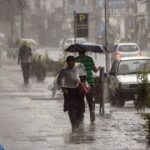WHO REPORT
Since 2021, there has been an increase in cholera cases and their geographical distribution globally. In 2021, 23 countries reported cholera outbreaks, mainly in the WHO Regions of Africa and the Eastern Mediterranean. This trend has continued into 2022 with over 29 countries reporting cholera cases or outbreaks. As of 30 November 2022, 16 of these have been reporting protracted outbreaks. Many of those countries reported higher case numbers and case fatality ratio (CFR) than in previous years. The average cholera CFR reported globally in 2021 was 1.9% (2.9% in Africa), well above acceptable (<1%) and the highest recorded in over a decade.
This year the number of cholera cases and cholera-associated deaths have surged globally following years of decline. Of particular concern are the outbreaks in 13 countries, which did not report cholera cases in 2021. Of these, some had not reported any cholera outbreaks for many years (between three and 30), and several are not considered cholera-endemic countries. The current situation represents a resurgence of the ongoing seventh pandemic of cholera which began in 1961.
The simultaneous progression of several cholera outbreaks, compounded in countries facing complex humanitarian crises with fragile health systems and aggravated by climate change, poses challenges to outbreak response and risks further spreading to other countries. The overall capacity to respond to the multiple and simultaneous outbreaks is strained due to the global lack of resources, including the oral cholera vaccine, as well as overstretched public health and medical personnel, who are often dealing with multiple disease outbreaks at the same time.
Cholera is an acute diarrheal infection characterized, in its severe form, by extreme watery diarrhea and potentially fatal dehydration. It is caused by the ingestion of food or water contaminated with the bacterium Vibrio cholerae. It has a short incubation period, ranging between two hours and five days. Most people will develop no or only mild symptoms; less than 20% of ill persons develop acute watery diarrhoea with moderate or severe dehydration and are at risk for rapid loss of body fluids, dehydration, and death. Despite being easily treatable with rehydration solution, cholera remains a global threat due to its high morbidity and mortality in vulnerable populations with a lack of access to adequate health care.
Seven distinct pandemics of cholera have been recorded during the past two centuries. The seventh pandemic, which is still ongoing today, is considered to have occurred principally between 1961 to 1974. During this period, following (re)introduction, many countries transitioned to becoming cholera-endemic. While global incidence greatly decreased in the late 1990s, cholera remained prevalent in parts of Africa and Asia. The global burden of cholera is largely unknown because the majority of cases are not reported, however, previous studies estimate 2.9 million cases, and 95,000 deaths occur annually.
The main drivers and challenges for controlling and containing the current cholera outbreaks are outlined below. Yet, addressing the need for, and lack of funding to prevent outbreaks is critical. Large-scale investments in water and sanitation infrastructure have largely led to the elimination of cholera in Europe and the Americas. Significant investments should support water, sanitation, and hygiene (WASH) interventions for cholera prevention and control. Such interventions should consider the social context and be supported by the best available evidence and updated models of cholera transmission.
Of the countries that have reported cholera outbreaks in 2022, many are experiencing natural disasters such as cyclones (Mozambique, Malawi), flooding (Pakistan, Nigeria), and drought (countries in the Horn of Africa). Major flooding and above-normal hurricane seasons increase outbreak severity and the propensity for regional spread. The upcoming rainy/cyclone season, which is predicted to be severe, has the potential to spread the disease across Southern Africa. The above-normal hurricane season in the Americas is affecting several countries in the Caribbean and Central America causing major flooding. Post-monsoon season (and post-floods) is usually associated with a cholera peak in South Asia. Additionally, many countries experienced droughts leading to cholera2 due to poor access to water, marginalization of refugees and nomadic populations, and expansion of informal urban settlements.
Increasing humanitarian crises due to conflict, political instability, and a lack of development are leaving an increasing number of people at risk for cholera across all WHO regions. Of the countries that have reported outbreaks, nine are experiencing conflict or political violence in affected areas (Afghanistan, Cameroon, the Democratic Republic of Congo, Haiti, the Islamic Republic of Iran, Nigeria, Somalia, the Syrian Arab Republic, and Yemen). In two of these countries (Ethiopia and Cameroon), the current outbreak is not affecting conflict areas, but there is a high risk of spreading into areas of ongoing conflict, which would complicate the response.
Several countries with cholera outbreaks are also responding to multiple other disease outbreaks including mpox (monkeypox), dengue, chikungunya, measles, and the ongoing COVID-19 pandemic. This also strains the overall response capacity to cholera, particularly in countries with limited resources. The global supply of cholera kits is depleted, and suppliers are struggling to meet demand. Delays or shortages of medical supplies can lead to preventable and avoidable deaths. WHO is facilitating global coordination and alternate sources of supply are being sought, but these will not be available immediately.
The number of outbreaks and geographic scope has stretched the capacity of healthcare services to implement a comprehensive multi sectoral response. Parallel large-scale, high-risk outbreaks and other public health and humanitarian crises are further stretching resources and limiting the capacity to respond. In addition, the emigration of skilled medical personnel during a humanitarian crisis, interruption in routine health services such as vaccination leading to (re)-emergence of vaccine-preventable diseases, destruction or inaccessibility of healthcare infrastructure, and violence against health workers have hindered outbreak response activities.
WHO is working with partners at global, regional & country level to support member states for providing a forum for technical expertise exchange through the Global Task Force on Cholera Control (GTFCC) coordination, and cooperation on cholera-related activities to strengthen the country’s capacity to prevent and control cholera. WHO teams are working closely with Member States and partners to strengthen risk communication and community engagement plans and strategies, adapted to local beliefs and contexts, to encourage behavioural change and adoption of appropriate protective measures such as vaccination, and ensuring safe food, water, and hygiene practices. Providing support to increasing risk perception and knowledge among communities about the disease, its symptoms, associated risks, precautions to take, and when to seek treatment when symptoms appear.
(The author is a regular columnist and can be mailed at [email protected])





